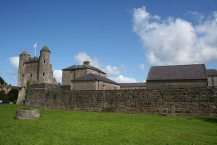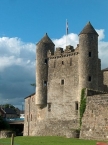Enniskillen Castle
Worth visiting
Added on 17 Jan 2019,
last edited by »biroto-Redaktion« on 17 Jan 2019
Nearby cycle routes and tours
| Route name | Type | Dist. to route |
|---|---|---|
Route | 0,0 km | |
Route | 0,0 km | |
Route | 0,1 km | |
Tour | 0,1 km |
![]()
Please wait - map data are loading
Type of sights
Castle/palace
Name and address
Enniskillen Castle
GB-BT74 7EW Enniskillen
GEO-data
Geodetic coordinates
54.346151 -7.644768
Elevation
42 m
Communication
Phone
+44 ∎∎ ∎∎∎∎ ∎∎
Internet
∎∎∎.∎∎∎∎∎∎∎∎∎∎∎∎∎∎∎∎∎.∎∎.∎∎/


Enniskillen Castle is situated in Enniskillen , County Fermanagh, Northern Ireland. It was originally built in the 16th century and now houses the Fermanagh County Museum and the regimental museum of the Royal Inniskilling Fusiliers and the 5th Royal Inniskilling Dragoon Guards.
History
The first Enniskillen castle was built on this site by Hugh Macguire in 1428. It featured greatly in Irish rebellions against English rule in the 16th century and was taken after an eight-day siege in 1594. Captain William Cole remodelled and refurbished the castle adding the riverside tower at the south, known as the Watergate, in 1609. The castle was remodelled as “Castle Barracks” as part of the response to a threat of a French invasion in 1796. Castle Barracks became the home of the 27th Regiment of Foot in 1853. The regiment moved to purpose-built facilities at St Lucia Barracks, Omagh in 1875 and evolved, after amalgamation, to become the Royal Inniskilling Fusiliers in 1881.
The barracks continued to be used by other regiments and, from November 1939, they became to home of the North Irish Horse, a Territorial Army unit. The barracks were decommissioned in 1950 and were converted for use as council depot. The castle was subsequently opened to the public as a heritage centre.
Features and collections
The Castle provided the main defence for the west end of the town and guarded the Sligo road. It consists of two sections, a central tower keep and a curtain wall which was strengthened with small turrets called Bartizans. The design of the castle has strong Scottish influences. This can be particularly seen in the Watergate, which features two corbelled circular tourelles which were built about 1609. It is a State Care Historic Monument.
The castle is now home to the Fermanagh County Museum, which focuses on the county's history, culture and natural history. Exhibits include the area's prehistory, natural history, traditional rural life, local crafts and Belleek Pottery, and history of the castle. It also contains information on the Maguire family. The castle also houses the Inniskillings Museum, which is the regimental museum of the Royal Inniskilling Fusiliers and the 5th Royal Inniskilling Dragoon Guards.
Information about copyright | |
|---|---|
Rights characteristic / license | by-sa: CREATIVE COMMONS Attribution-ShareAlike |
Link to the description of the license | |
Input taken over from: |
Wikipedia contributors, 'Enniskillen Castle', Wikipedia, The Free Encyclopedia, 3 December 2018, 06:24 UTC, <https://en.wikipedia.org/w/index.php?title=Enniskillen_Castle&oldid=871757422> [accessed 17 January 2019] |
taken over / edited on | 17 Jan 2019
|
taken over / edited by |
|
Hours of opening:
Monday to Friday (all year round): 9.30am - 5.00pm
Saturdays (all year round): 11.00am - 5.00pm
Sundays (Jun to Sept): 11.00am - 5.00pm
Nearby cycle routes and tours
| Route name | Type | Dist. to route |
|---|---|---|
Route | 0,0 km | |
Route | 0,0 km | |
Route | 0,1 km | |
Tour | 0,1 km |
Added on 17 Jan 2019,
last edited by »biroto-Redaktion« on 17 Jan 2019
